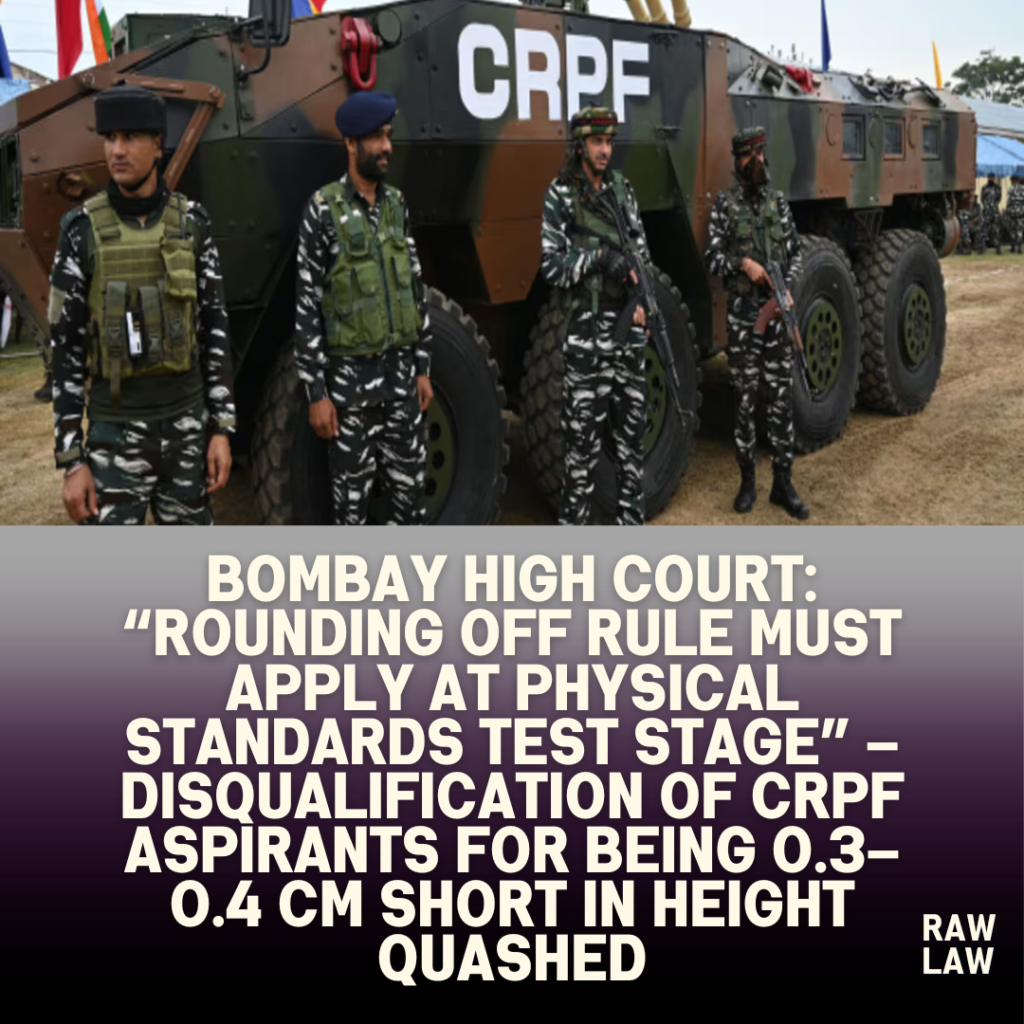Court’s Decision
The Division Bench of the Bombay High Court (Justices Ravindra V. Ghuge and Ashwin D. Bhobe) quashed the disqualification of two 21-year-old aspirants for the post of Constable (GD) in CAPFs, Rifleman (GD) in Assam Rifles, and Sepoy in NCB. The Court held that under Clause 2(d) of the 2015 Revised Uniform Guidelines, height measurements must be rounded off to the next higher centimeter even at the Physical Standard Test (PST) stage. Declaring the disqualification as “illegal and arbitrary,” the Court directed that both petitioners be treated as having the requisite 165 cm height and be allowed to proceed to the Detailed Medical Examination (DME).
Facts
- SSC issued recruitment notice (05.09.2024) for Constable (GD), Rifleman, and Sepoy posts.
- Recruitment had three stages: (1) Computer-Based Exam, (2) PST & PET, (3) DME.
- Petitioners cleared CBT and PET.
- At PST in August 2025, petitioner in WP 12664 was measured at 164.7 cm and petitioner in WP 12671 at 164.6 cm; both were rejected as below 165 cm standard for Maratha category.
- They sought application of Clause 2(d) of the 2015 Guidelines, which mandates rounding off 0.5 cm and above, while ignoring fractions below 0.5 cm.
- Petitioners cited precedents from MP High Court (Arun Kalmodiya), Calcutta HC (Anuj Bala), and Punjab & Haryana HC (Kuldeep).
Issues
- Whether Clause 2(d) of the 2015 Revised Uniform Guidelines applies at the PST stage.
- Whether rejection of candidates for being marginally short of 165 cm was arbitrary.
Petitioners’ Arguments
- Clause 2(d) of the Guidelines explicitly applies to PST measurements, not only to DME.
- Being short by 0.3–0.4 cm falls within rounding tolerance; hence, they should be declared qualified.
- Cited High Court rulings consistently extending rounding benefit to PST rejections.
- Denial of such benefit causes grave prejudice by excluding them before DME.
Respondents’ Arguments
- Rounding off is permissible only at DME stage, not PST.
- PST Rejection Slips were correct since both candidates were under 165 cm at the time of measurement.
- Clause 2(d) cannot be read to dilute prescribed standards at PST stage.
Analysis of the Law
- Scheme of Recruitment: PST is a qualifying stage where physical measurements are decisive. Clause 2(d) governs measurement responsibility of PST Board.
- Text of Clause 2(d): Explicitly provides that fractions <0.5 cm are ignored; ≥0.5 cm rounded to next cm. Thus, 164.7 and 164.6 cm must be treated as 165 cm.
- Court’s View: Rejecting candidates despite this guideline was contrary to law and arbitrary.
- Precedents: Other High Courts have consistently extended benefit of rounding to aspirants marginally short in height.
Court’s Reasoning
- Clause 2(d) applies at PST itself, not merely at DME.
- “Disqualifying the Petitioners at the stage of Physical Standard Test on account of their height being 164.7 cms and 164.6 cms, respectively, is illegal and arbitrary.”
- Petitioners, having cleared CBT and PET, should not be eliminated at PST on a hyper-technical view.
Conclusion
- Both writ petitions allowed.
- Heights of 164.7 cm and 164.6 cm rounded to 165 cm.
- Petitioners declared eligible for DME.
- Rule made absolute. No order as to costs.
Implications
- Clarifies that rounding off rule applies at PST stage itself.
- Prevents unfair disqualification of candidates on negligible height shortages.
- Ensures uniform application of the 2015 Revised Guidelines across CAPF recruitment.
- Strengthens judicial scrutiny over recruitment authorities’ strict interpretation of eligibility norms.



